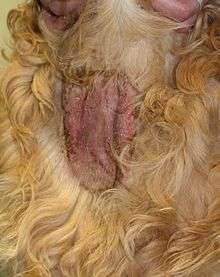Pyotraumatic dermatitis

Pyotraumatic dermatitis, also known as a hot spot or acute moist dermatitis, is a common infection of the skin surface of dogs, particularly those with thick or long coats.[1] It occurs following self-inflicted trauma of the skin.[1] Pyotraumatic dermatitis rarely affects cats.[1]
Signs
The dog persistently licks, chews, scratches or rubs at a focal area of skin,[2] which quickly causes hair loss.[1] The skin becomes red, moist and weeps.[1] The affected area is obviously defined and separate from the surrounding healthy skin and coat.[1] Usually only one area of the skin is affected.[1] The size of the affected area is variable.[3] If the area is difficult for the dog to itch, or if the disease is caught early, hair may still be present.[3] Areas commonly affected include the rump above the tail, the head and neck near the ears, and the top and sides of the lumbar area.[3]
Cause
Pyotraumatic dermatitis is caused by self-inflicted trauma to the skin, which is incited by pain or irritation, such as infestation with fleas, or lice,[4] irritation from clippers,[3] allergic skin diseases,[4] diseases of the anal sacs,[4] inflammation of the ear canal,[4] foreign bodies or irritants within the coat,[4] yeast or bacterial infection,[5] or pain in muscles or joints.[4] Skin maceration from repeated wetting of the coat or moisture in the fur can also be an inciting cause.[3] Flea infestations are the most common inciting factor.[1]
The inciting factor causes the dog to traumatize a small area of skin.[2] The affected skin weeps (that is, it exudes serum),[3] and this moist surface layer of skin can become colonized by bacteria, although the skin itself is not infected.[4] The affected area is usually painful, as nerve endings are exposed when the surface of the skin is eroded.[6] Hair which remains in the affected area holds in the moisture and further irritates the skin surface.[7] Continued itching by the dog can cause the affected area to enlarge rapidly in only a few hours.[4]
Pyotraumatic dermatitis is more common when the dog's environment is hot and humid.[3] Dogs with thick undercoats or long fur are most commonly affected,[1] but pyotraumatic dermatitis can occur in any dog.[4] Commonly affected breeds include the Labrador Retriever, Golden Retriever, German Shepherd and St. Bernard.[4]
Treatment
There are several aspects to treatment: breaking the "itch-scratch" cycle by clipping the fur and cleaning the skin;[6] addressing the underlying painful or itchy condition which initially caused the animal to begin scratching;[2] and relieving the dog's discomfort, for example with steroid medications.[3]
The hair in and around the affected area is clipped before the skin is cleaned with an antiseptic, rinsed, and dried.[3] The dog may require sedation before the fur is clipped, as skin affected by pyotraumatic dermatitis can be painful.[3]
With treatment, pyotraumatic dermatitis resolves in 3–7 days, but can recur if the inciting factor is not addressed.[3]
References
- 1 2 3 4 5 6 7 8 9 Hnilica, Keith A.; Patterson, Adam P. (2016). "Chapter 3. Bacterial skin diseases. Pyotraumatic dermatitis". Small Animal Dermatology: A Color Atlas and Therapeutic Guide (4th ed.). St. Louis, Missouri: Elsevier. pp. 49–50. ISBN 978-0-323-37651-8.
- 1 2 3 Lewis, Diane T. (2016). "Chapter 18 Dermatologic disorders. Pyotraumatic dermatitis". In Schaer, Michael; Gaschen, Frederic P. Clinical Medicine of the Dog and Cat (3rd ed.). CRC Press. p. 779. ISBN 9781482226072.
- 1 2 3 4 5 6 7 8 9 10 11 Tim, Nuttall; Harvey, Richard G.; McKeever, Patrick J. (2009). "Chapter 1: Pruritic dermatoses. Pyotraumatic dermatitis". Skin Diseases of the Dog and Cat a Colour Handbook (2nd ed.). London: CRC Press. p. 18. ISBN 978-1-84076-539-7.
- 1 2 3 4 5 6 7 8 9 10 Miller, William H., Jr.; Griffin, Craig E.; Campbell, Karen L. (2013). "Pyotraumatic dermatitis". Muller & Kirk's Small Animal Dermatology (7th ed.). St. Louis, Missouri: Elsevier. pp. 677–678. ISBN 9781416000280.
- ↑ "Take Action Now on Your Dog Hot Spot!". Vet Organics. Retrieved 2018-09-17.
- 1 2 Moriello, Karen A. (2011). Small Animal Dermatology (6th, rev. ed.). London: CRC Press. p. 90. ISBN 9781840766356.
- ↑ Susan M. Ewing. Poodles For Dummies. Retrieved December 29, 2012.